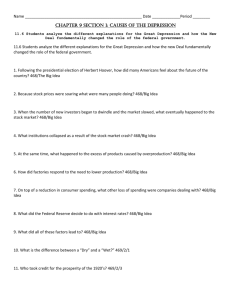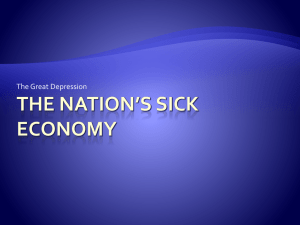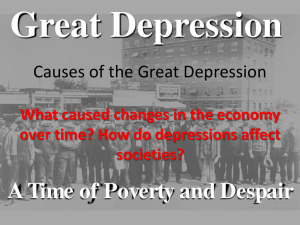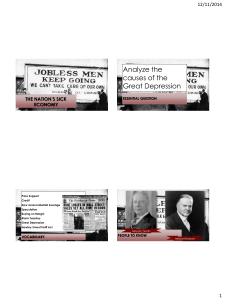1920s Great Depression and New Deal - Mr. Lilly
advertisement
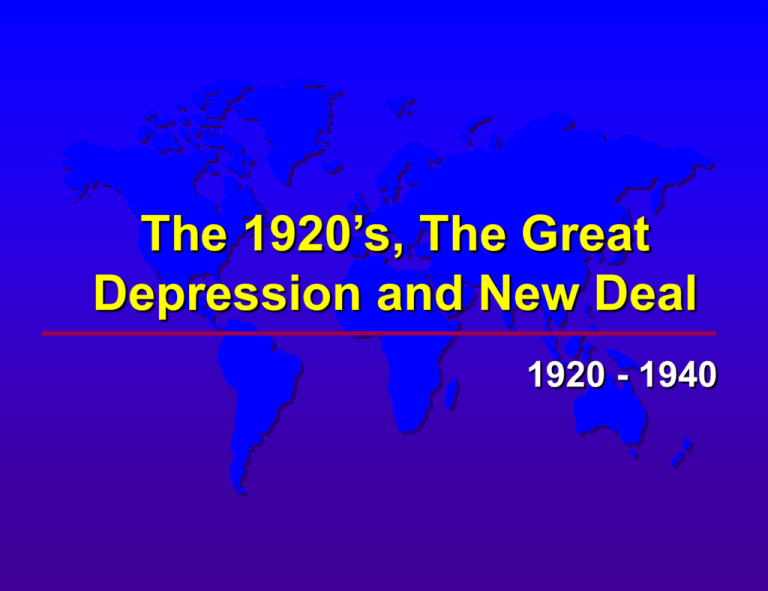
The 1920’s, The Great Depression and New Deal 1920 - 1940 During the 1920's there is great prosperity Businesses are booming Women 19th Amendment in 1920 – Right to vote Flappers - fashionable young woman intent on enjoying herself and breaking standards of behavior Entertainment Newspapers/magazine shape cultural fads Radio broadcasts news, jazz and Fireside chats First movies w/sound (Jazz Singer) Escape for people during the Great Depression Scopes Trial New KKK Darwin’s Theory of Evolution John T Scopes, an educator, arrested for teaching evolution Anti-foreign, anti-Catholic, anti-black, anti-Jewish, antipacifist, anti-Communist, anti-internationalist, antirevolutionist, anti-bootlegger, anti-gambling, anti-adultery, and anti-birth control. Prohibition – 18th Amendment Prohibits alcohol Leads to smuggling by gangsters/mobsters and speakeasies (illegal bar/nightclub) Black Tuesday October 29, 1929 The Great Depression is caused by: Over production by business Reckless investment practices (Collapse of the Stock Market) Over speculation of the Stock Market Buying on Margin Banking collapses (Cause and Effect) High protective tariffs What happens to inventory when you have companies continuing to make products and no one buys them? Products build up producing a surplus Then when you have a surplus what happens to prices? Prices Drop What happens to a companies profits when prices drop? They drop What happens to workers when companies are not making money? Workers get laid off What happens when workers get laid off? They can't afford to by products so supply stays high and demand remains low. More workers get laid off and the downward trend continues. This is Supply and Demand Unemployment today is about 5.5%; during the Great Depression it was 25% or more (1932 - 1934) Early 1920’s, supply was very high and at the beginning of the 1920's so was demand, keeping prices steady Late 1920's, demand was slacking off; businesses didn't drop their production The increase supply causes the businesses to cut their labor force thus helping to cause the Great Depression. What is Over Speculation? Paying more for stocks than they are worth, because you believe they will go up in value Reckless Investment – Buying on Margin People used borrowed money to buy stocks Great Depression Causes: Over Speculation of Stocks and Stock Market Crash Price Per # of Shares Total Price $ Borrowed if $ you get at Share on Margin sale $1.00 100 $100 $0 (Not on $100 margin) Great Depression Causes: Over Speculation of Stocks and Stock Market Crash Price Per # of Shares Total Price $ Borrowed if $ you get at Share on Margin sale $1.00 100 $100 $0 (Not on $100 margin) $1.00 100 $100 $90 $10 Great Depression Causes: Over Speculation of Stocks and Stock Market Crash Price Per # of Shares Total Price $ Borrowed if $ you get at Share on Margin sale $1.00 100 $100 $0 (Not on $100 margin) $1.00 100 $100 $90 $10 $3.00 Price increases 100 $300 $0 $300 Great Depression Causes: Over Speculation of Stocks and Stock Market Crash Price Per # of Shares Total Price $ Borrowed if $ you get at Share on Margin sale $1.00 100 $100 $0 (Not on $100 margin) $1.00 100 $100 $90 $10 $3.00 Price increases $3.00 Price Increases 100 $300 $0 $300 100 $300 $90 $210 Great Depression Causes: Over Speculation of Stocks and Stock Market Crash Price Per # of Shares Total Price $ Borrowed if $ you get at Share on Margin sale $1.00 100 $100 $0 (Not on $100 margin) $1.00 100 $100 $90 $10 $3.00 Price increases $3.00 Price Increases $0.50 Price Decreases 100 $300 $0 $300 100 $300 $90 $210 100 $50 $0 $50 Great Depression Causes: Over Speculation of Stocks and Stock Market Crash Price Per # of Shares Total Price $ Borrowed if $ you get at Share on Margin sale $1.00 100 $100 $0 (Not on $100 margin) $1.00 100 $100 $90 $10 $3.00 Price increases $3.00 Price Increases $0.50 Price Decreases $0.50 Price Decreases 100 $300 $0 $300 100 $300 $90 $210 100 $50 $0 $50 100 $50 $90 - $40 Business Cycle: Comparison 350 After Great Depression Before Great Depression 400 350 300 300 Stock Value Stock Value 250 200 150 100 250 200 150 100 50 50 0 0 Years Years Answer the following: Briefly explain how over production helped to cause the Great Depression. Briefly explain the way buying on margin helped to cause the Great Depression. Federal Reserve's failure to prevent collapse of the nation's banking system in late 20's and early 30's. This led to contraction in the nation's money supply. What is the Federal Reserve? What is Contraction? So, Banks began to collapse but why? You put your $ in the bank say $1000. The bank then lends your $ out (with interest) to someone else. This how the bank makes $ The collapse takes place when you (and everyone else) want their money out of the bank. The money has been loaned out and there is no money to pullout, the bank closes. With so many banks closing the amount of money out there begins to shrink. Example. The bank has $100,000 in it from 10 different people. The bank takes that $100,000 and loans out $60,000 of it. Now when the economy starts to go bad, like it did in the late 1920's early 1930's, the 10 people want their $100,000. However, the bank only has $40,000. The Bank goes to the people it loaned the $ to, they can't pay. So, the bank can't pay the 10 people their $, it shuts down. Great Depression Causes: High Tariffs IMPORTANT FACT: High protective tariffs like the Tariff Act of 1930 (Hawley-Smoot Act) that produced retaliatory tariffs in other countries, slowing world trade. In 1930, the US passed the Tariff Act of 1930. Hawley-Smoot Act This raised tariffs to their highest level in US history: 60%. (Remember that a tariff is a tax placed on imports from another country.) Any country trading with the US, their products would be more expensive than they were before. This causes other countries to raise their tariff rates. Great Depression Causes: High Tariffs (video) So, in a nut shell the whole world stops trading with each other because they will not make any money. They will not make $ because no one will buy imported goods, they are too expensive. IMPORTANT QUESTION: What were the causes of the Great Depression? OVER PRODUCTION RECKLESS INVESTMENT PRACTICES over speculation on stocks, using borrowed money to buy stocks, stock market crash. FEDERAL RESERVE'S FAILURE TO KEEP THE BANKING SYSTEM FROM COLLAPSING. HIGH PROTECTIVE TARIFFS LIKE THE HAWLEYSMOOT TARIFF ACT. (1930) Unemployment and Homelessness Collapse of Financial system (bank closings) Political unrest (Hoovervilles and Blankets) (growing militancy of labor unions) Farm foreclosures and migration What are foreclosures? Dust Bowl Unemployment during the Great Depression Unemployment % of nonfarm workers unemployed 40 12,830,000 30 10,390,000 7,700,000 20 4,918,000 10 0 1920 2,190,000 1,982,000 1,049,000 801,000 1926 670,000 1932 1935 Years 1940 1945 The New Deal 1933 - 1940 Great Depression caused hardships 1930 – 1932, government does little to help out Herbert Hoover believed the economy would fix itself 1932 election Franklin Delano Roosevelt crushes Hoover Franklin D. Roosevelt (FDR) wanted to change the role of government. It should be more active in solving the problems of the country. FDR, in his inauguration speech, rallied the people when he stated “Only thing we have to fear is fear itself." New Deal New Deal tries to fix causes and effects 3 ways Relief Recovery Reform New Deal Agencies Glass-Steagall Act Civilian Conservation Corps Works Progress Administration National Recovery Act Public Works Administration 1st Agricultural Adjustment Act Securities and Exchange Commission Tennessee Valley Authority Federal Housing Authority Social Security Act Wagner Act Fireside Chats Emergency Banking Relief 2nd Agricultural Adjustment Act Indian Reorganization Act Fair Labor Standards Act Unemployment was an effect of the depression. To fix this…the "new deal" came up with Works Progress Administration (WPA). People were given jobs by the government. These relief measures provided direct payment to people for immediate help Farmers having problems was also an effect of the depression. To fix this…the “New Deal“ came up with the Agricultural Adjustment Administration (AAA) This would help bring the nation out of the depression over time. Like reducing the number of pigs or gallons of milk. Banking closures were a cause of the depression To fix this…the “New Deal" came up with the Federal Deposit Insurance Corporation (FDIC). This reform measure corrected unsound banking and investment practices to prevent future problems. People not having savings in the bank in later life was an effect of the Great Depression Social Security Act offered safeguards for workers Provides for retirement and worker benefits like disability (SSI and SSDI). Understand, this time period deeply changed America and the American people. A whole generation of Americans went without, thus affecting future generations (i.e. Baby Boomers) This era saw a change in the role government played in the lives of the American people. New Deal Legacy – Government is responsible for some public services and promote general welfare Unemployment during the Great Depression Unemployment % of nonfarm workers unemployed 40 12,830,000 30 10,390,000 7,700,000 20 4,918,000 10 0 1920 2,190,000 1,982,000 1,049,000 801,000 1926 670,000 1932 1935 Years 1940 1945

